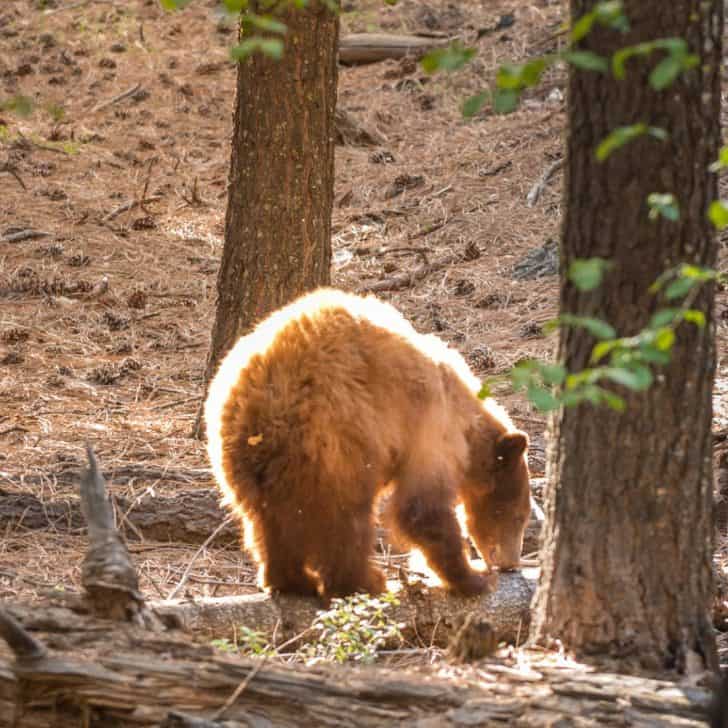From the black bear to the bobcat, animals in Yosemite have been delighting visitors for generations who yearn to see wildlife in their natural habitat. Long gone are the days of feeding wildlife for entertainment. Today, there is a focus on conservation and letting the wildlife remain wild.
Here are some of the mammals that call this park home. Yosemite animals are varied, given the the park’s many landcapes and elevations. Some are certainly more common than others, but an animal sighting is always something to get excited about. Just be respectful and keep your distance.
In addition to the animals listed below, there are a wide variety of rodents such a mice, voles, woodrats, and gophers living inside the park.
Short on time? Here is your guide to one day in Yosemite.
Animals in Yosemite- 21 Mammals That Call the Park Home
Black Bear
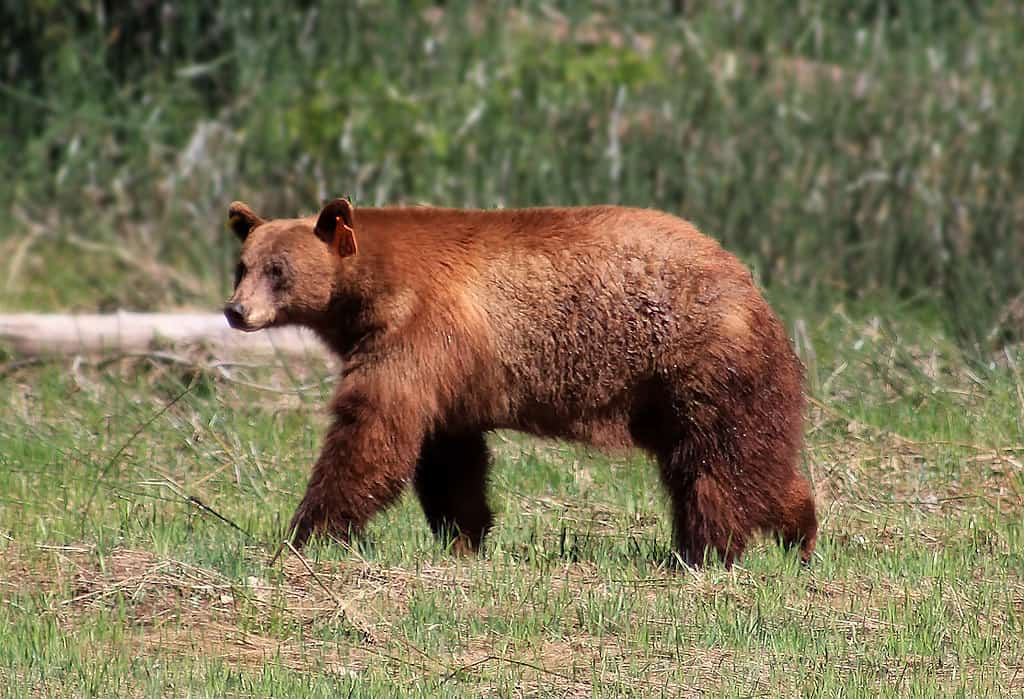
Where to Spot this Animal in Yosemite: I have seen black bears all throughout the park- in the Yosemite Valley, near High Country campgrounds, and in Sequoia Groves.
The animal that most folks come to Yosemite National Park hoping to see is the black bear. There are about 300-500 that live in the park. Keep in mind that the black bear species are not always black; many are brown, reddish brown, or even blond in color. If you see a bear in Yosemite, it’s a black bear as grizzly bears were eradicated from California in 1924.
Black bears are significantly smaller than grizzlies you may have seen in parks like Yellowstone or Glacier. Males tend to weigh around 250lbs and females about 150lbs. Bears in Yosemite tend to mostly eat grass or berries, but they do love snacking on acorns from the local oak trees during the fall.
Black bears do hibernate, and the hibernation season is dependent on weather. They typically hibernate through winter and come back out weighing 1/3 less in March or April. During this time females may also emerge from their dens with one to three cubs. The cubs are adorable, but be sure to never get between a mom and her cubs!
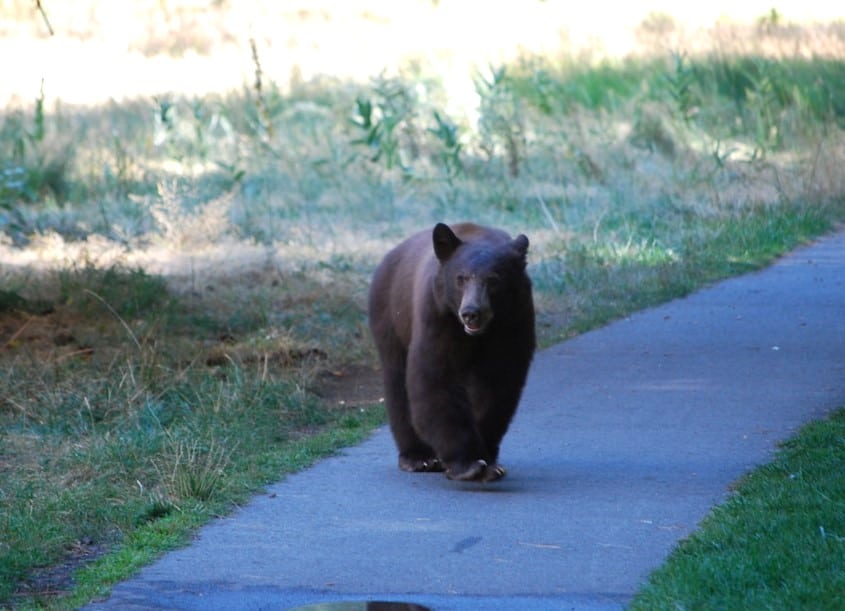
The bears in Yosemite are quite used to people, and nobody has ever been killed or seriously injured by a bear in Yosemite. Still, you want to give them plenty of distance. A good rule of thumb is to give them 50 yards of space.
Bears are known to invade campgrounds, break into cars, and raid unattended backpacks. You can avoid this by never leaving food in your car and using the metal bear boxes inside the park to store your food.
Here are the best easy hikes in Yosemite National Park.
Mule Deer
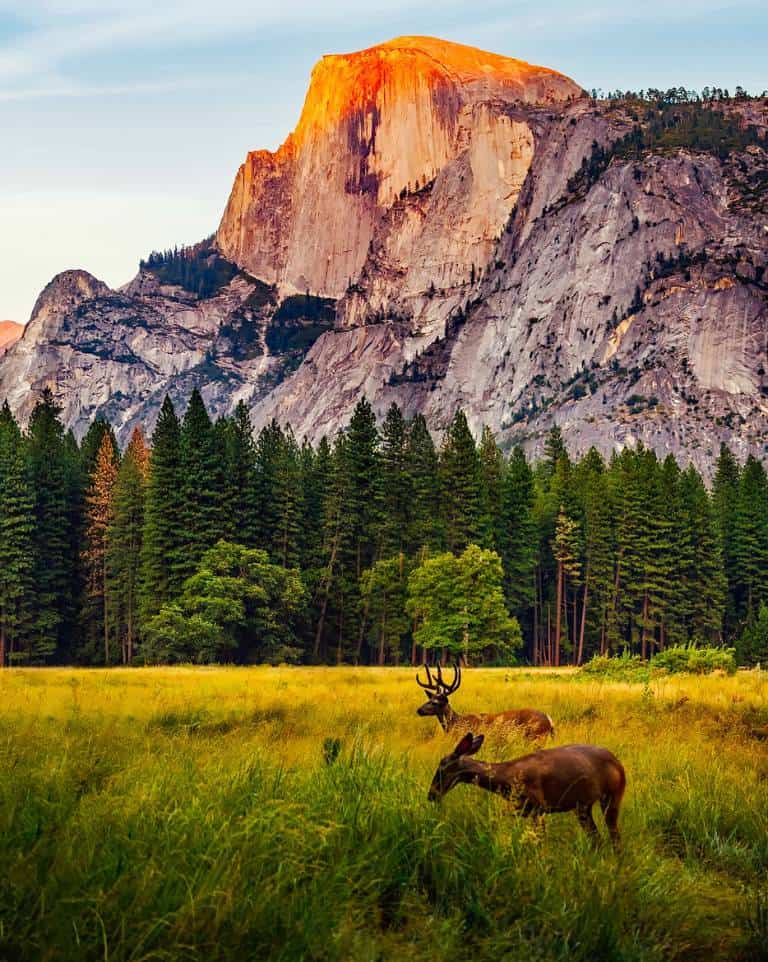
Where to Spot this Animal in Yosemite: You have a great chance of spotting mule deer along roads and in meadows of the Yosemite Valley. During the summer you may also spot them in the higher elevations, like in Tioga Meadow.
Did you know that more injuries in Yosemite are inflicted by mule deer than any other animals in Yosemite? These gentle looking animals may appear docile, but getting close to wildlife is never a good idea, especially during mating season.
Mule deer are the only deer species that call Yosemite home. They are known for their large ears and eat leaves, shurbs, berries, acorns, and grasses. These are large dear, typically measuring about four feet tall. Females are 150lbs, and males average around 200lbs.
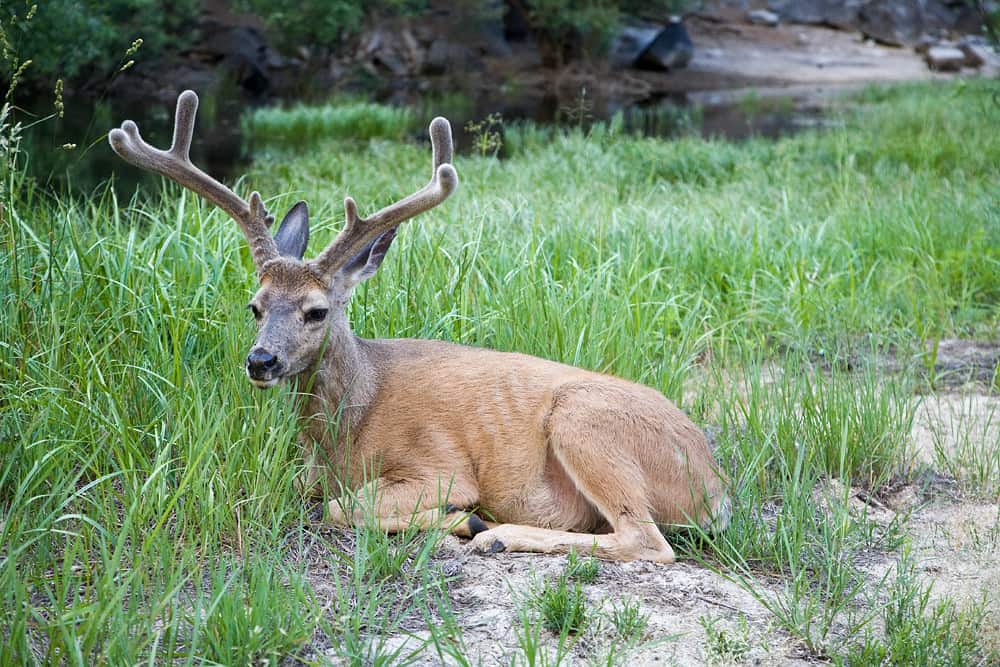
Only males grow antlers and they shed them annually in the winter after “rut” which is the time when they fight for mates. Fawns are born in the spring after a long, 200 day gestation period. They stay with their mothers until the fall.
Squirrel
Where to Spot this Animal in Yosemite: All over the park. Squirrel sightings are guaranteed.
There are several different squirrels that call Yosemite National Park. This is, by far, the most common animal you will see while exploring. They are especially common near parking lots, food establishments, and popular trails. Though they will beg, it is important not to feed the squirrels.
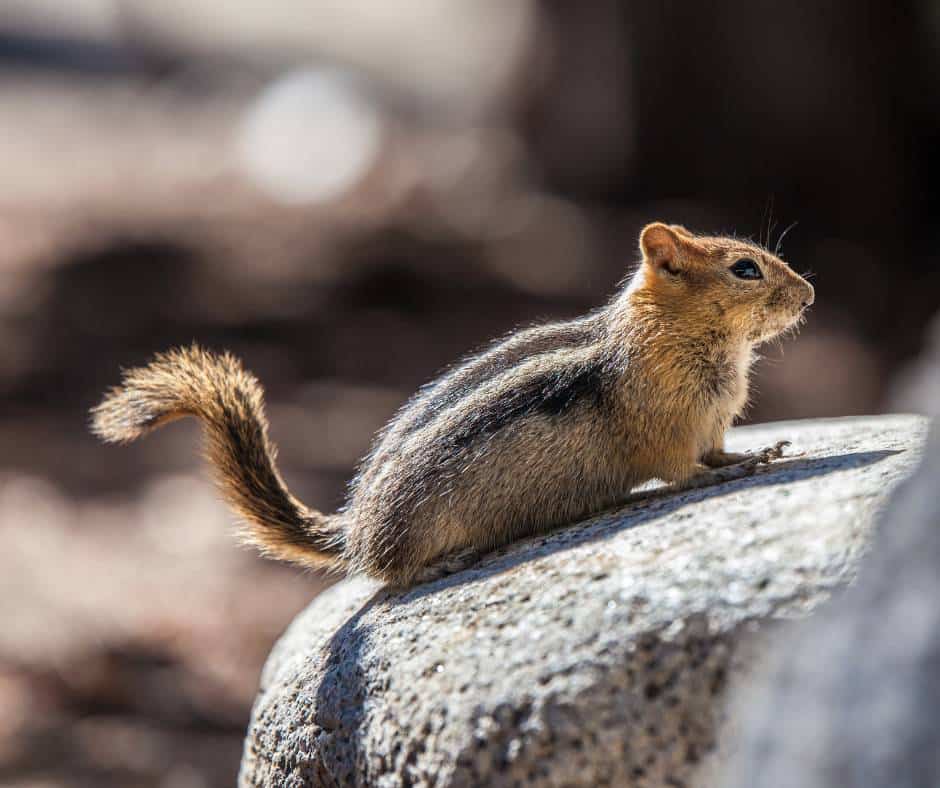
The golden-mantled ground squirrel is often mistaken for a chipmunk because of the distinct stripes on its back and its small size (adults weigh less than a pound). However, there are no chipmunks in California, so if you see anything resembling a chipmunk in the park, its a golden-mantled squirrel!
These ground squirrels hibernate during the winter so they spend much of the year building up fat storage. They can be quite the little beggars, but it is important for them to not gain a dependence on humans and remain wild, so please resist the urge to feed them.
They are found all over the park including on trails, in meadows, in rocky areas, and even in the higher elevation tundra.
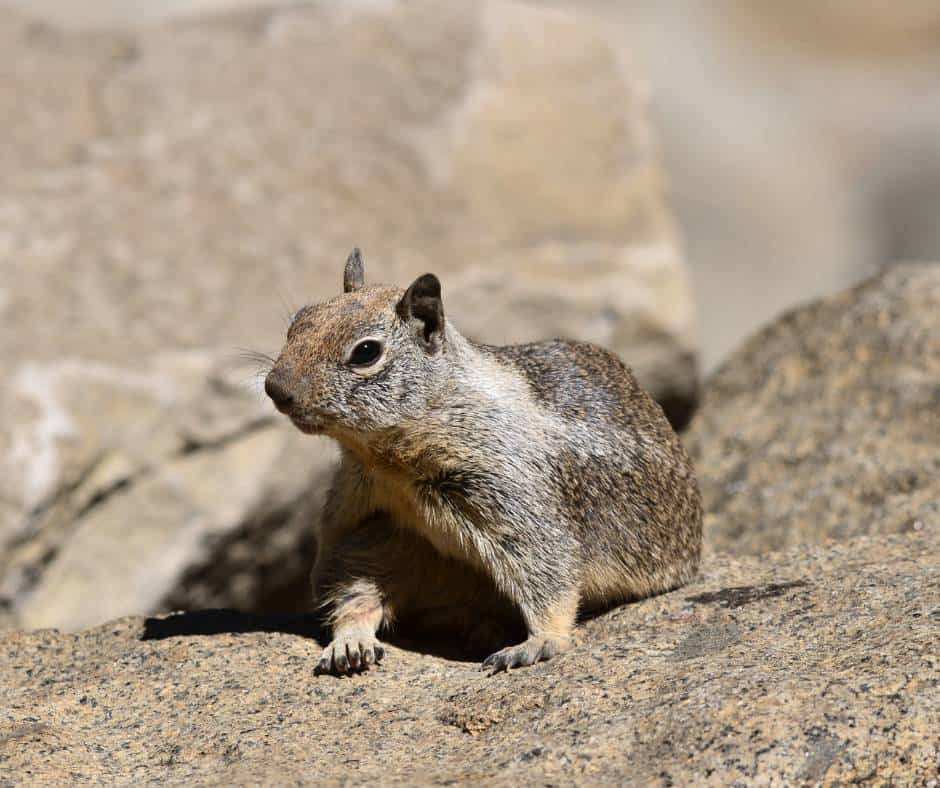
The California ground squirrel is the most commonly seen squirrel in Yosemite. As the name implies, it lives in burrows underground. It does hibernate during the winter and will certainly attempt to beg for food from park visitors.
These squirrels are mostly brown with mottled, light brown or white flecks.

The Western gray squirrel is know for its bushy gray tail. It is probably the squirrel species you are least likely to see since it spends nearly all of its time in trees and has a smaller population density in the Yosemite Valley than other varieties. It does stick to the lower elevations of the park.

The Douglas’s squirrel is a reddish tree squirrel that you will likely hear before you see. The squirrel has a distinct squeak. Its has darker brown fur with a distinct reddish-orange belly and light eye ring.
This squirrel lives in conifer trees like pine or fir because it loves to eat conifer seeds as well as the fungi that grow on the trees.
Listen to the sounds of the Douglas’s squirrel:
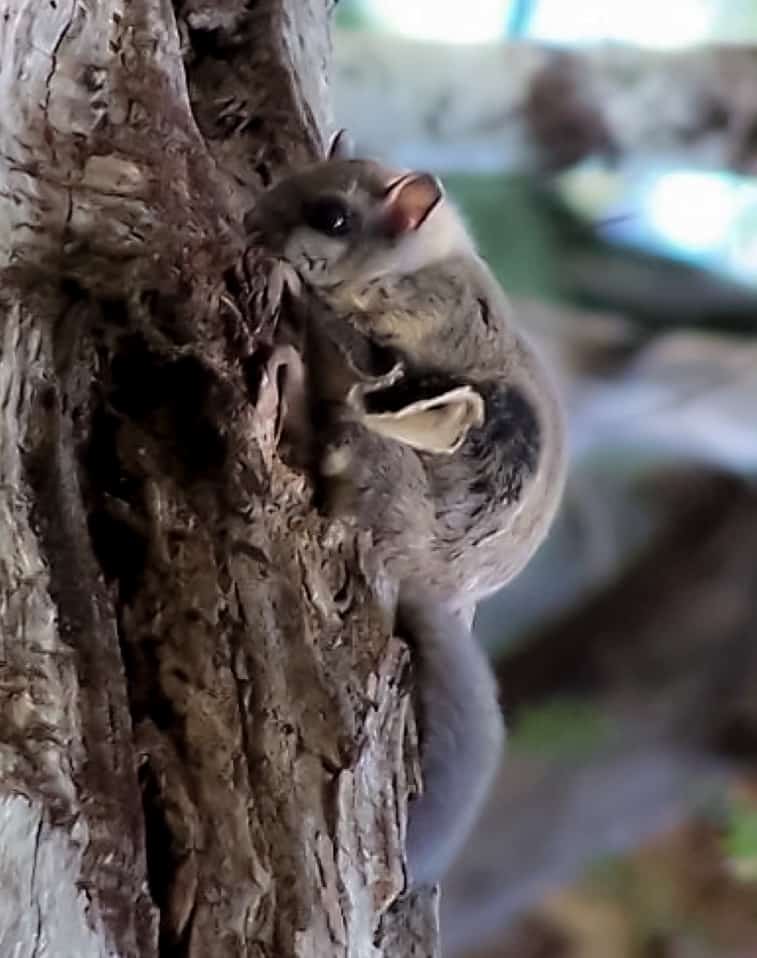
Humboldt’s flying squirrel, which is native to the West Coast, got its own species classification in 2017, due to its mitochondrial DNA being different from other North American flying squirrels.
This is a nocturnal species which uses the web of skin connectins its wrists and ankles to help it glide with ease from tree to tree. They can “fly” as much as 150 feet at a time. You are most likely to see them when light is shown into a tree and they are caught mid glide, looking like little shadows in the distance.
Coyote

Where to Spot this Animal in Yosemite: You are most likely to see coyotes hunting in the Yosemite Valley meadows during winter.
Many of us living in California are quite familiar with the coyote, and regularly see them living among us in both urban as well as rural areas. The coyotes that call my area of Orange County home tend to be much smallers and scrawnier than the beautiful mountain coyotes of Yosemite.
Living in a cooler climate and higher elevations has caused them to adapt with a thicker coat and a size closer to that of a wolf. Alas, wolves have not been spotted in Yosemite for over 100 years (except for one loan gray wolf passing through in 2021).
Coyotes head to lower elevations, like the Yosemite Valley, during the winter to hunt for prey like rodents and other small mammals. They listen for the sounds of these critters under the snow in meadows, and then pounce to snag a meal.
Skunk

Where to Spot this Animal in Yosemite: You are likely to see it in the Yosemite Valley or foothill regions of the park like Wawona.
The striped skunk is most commonly smelled before it is ever seen, but this adorable little animal is still seen rather commonly by Yosemite visitors, especially in the evening. Skunks are the size of a house cat and eat a variety of insects, worms, eggs, small amphibians and even small mice and voles. They will even forage on plants.
Skunks often don’t seem too concerned by the presence of humans, so it is best to give them a wide birth when encountered to avoid getting sprayed.
Spotted Skunk
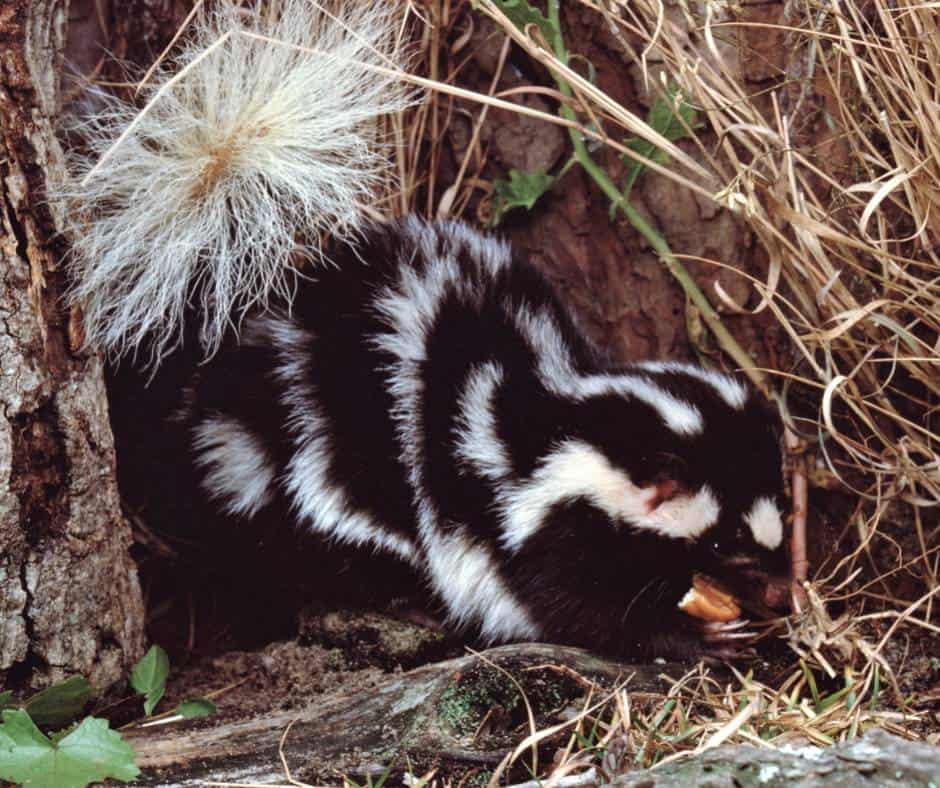
The spotted skunk is a far less commonly viewed species of skunk that also lives in Yosemite. It is most often seen in the lowest evelations of the park but does sometime make an appearace in the Yosemite Valley.
Spotted skunks are smaller than striped skunks, but they share their cousin’s nocturnal habits and food preferences. If they are threatened they have been know to stamp their feet and then stand on front feet and advance towards the threat in a handstand before spraying!
Grey Fox

Where to Spot this Animal in Yosemite: In lower elevations of the park, like Wawona. You might catch one with your car’s headlights in the lower parts of the park at night.
The gray fox is the most commonly spotted member of the canine family in Yosemite. It lives in the park’s lower elevations (including the Yosemite Valley at times), is quick, and is an excellent hunter.
They prefer to livein more shrubby areas where they can hunt their preferred prey, rodents and birds, easily. They are tree climbers and will eat some plants like berries, making them omivores. They are also known to scavenge garbage littered in the park.
Pika
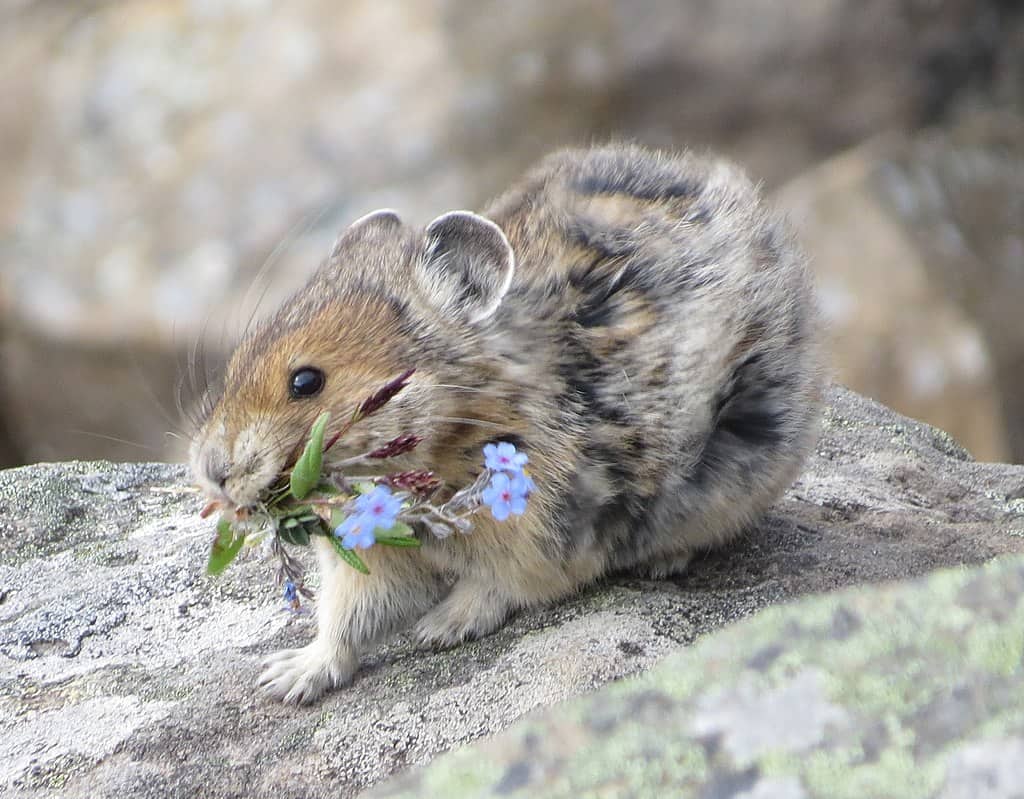
Where to Spot this Animal in Yosemite: Above the tree line in rock slides and rock outcrops. Check for them on the high portions of the trail to Mount Dana.
While the pika may look like a rodent in many ways, it is actually a lagomorph and closely related to rabbits. It is much smaller than a common rabbit, about a third of the size, and has much smaller ears and eyes. Still, it has rabbit-like fur and a similar jaw structure.
The rock rabbit, as it is sometimes called, is typically spotted by High Sierra hikers who know that if they remain quiet and patient near a rock slide ,then are likely to see them. They emit a loud, squeaking call and often sit atop a perch of boulders, squeaking away.
Pikas are experiencing shrinking territory due to global warming. Higher temperature in their high elevation home cause them to overheat. These days you won’t spot one below 9,500 feet.
Ringtail
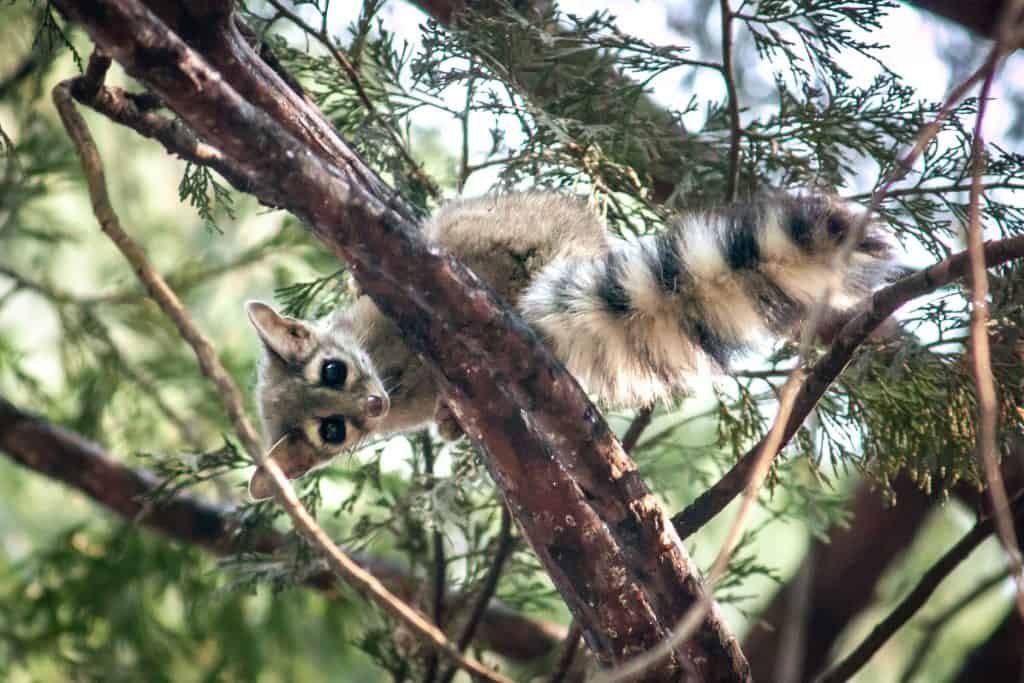
Where to Spot this Animal in Yosemite: Climbing around in a pine tree at night.
The ringtail is one of the most common animals in Yosemite that you may not see. This is because the ringtail is fully noctural. It looks part lemur, part raccoon, part fox, and part squirrel. It is most closely related to the raccooon, but is small like a squirrel.
The body is typically brown to brownish gray and as the name implies, it has a ringed tail. They are carnivores that primary eat rodents, though they will eat nuts and fruits as well. You are most likely see them while flashing a light into the trees in the evening.
Ringtails are known for getting into the attics of buildings inside the park in search of rodents, much like their raccoon cousins.
Raccoon

Where to Spot this Animal in Yosemite: The south entrance near Wawona and in the Yosemite Valley.
Raccoons are a species many suburban and rural residents are already familiar with. Those that live in Yosemite tend to do so in the lower portions of the park. Still, raccoons are far less common inside the park than ringtails.
They are being observed more and more in the Yosemite Valley these days, likely because of the presence of human food. Many visitors have reported that raccoons don’t seem particularly afraid of people and are willing to beg for food. Don’t give in to their adorable advances.
Here is a video of a raccoon hanging out on a balcony at Yosemite Valley Lodge.
Yellow Bellied Marmot
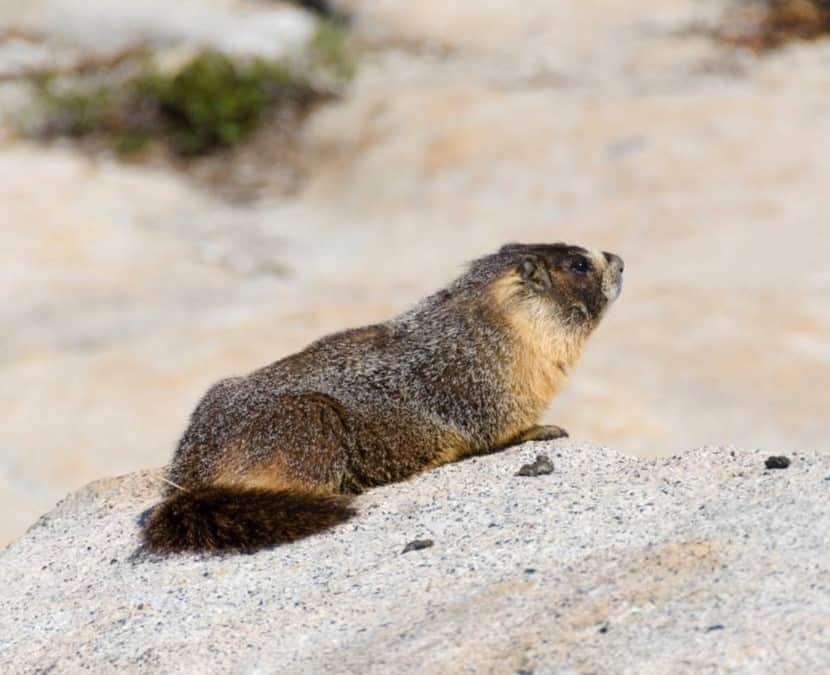
Where to Spot this Animal in Yosemite: In high elevations, sunning themselves on rocks. Check Olmstead Point, Mount Hoffman, or Gaylor Lakes off Tioga Road.
The largest rodent in park is the yellow-bellied marmot, a 5-11lb critter found bathing in the sunshine on rocks at higher elevations. Marmots hibernate for most of the year, staying in their burrows from September to May, so you will only see them in the summer.
Marmots eat plants, insects, and even bird eggs. They are usually quite alert, keeping an eye out for predators like eagles and then quickly darting to safety inside piles of rock. Yellow-bellied marmots let out a shrill whistle to alarm other marmots when they spot a threat and also defend their territory.
Bobcat
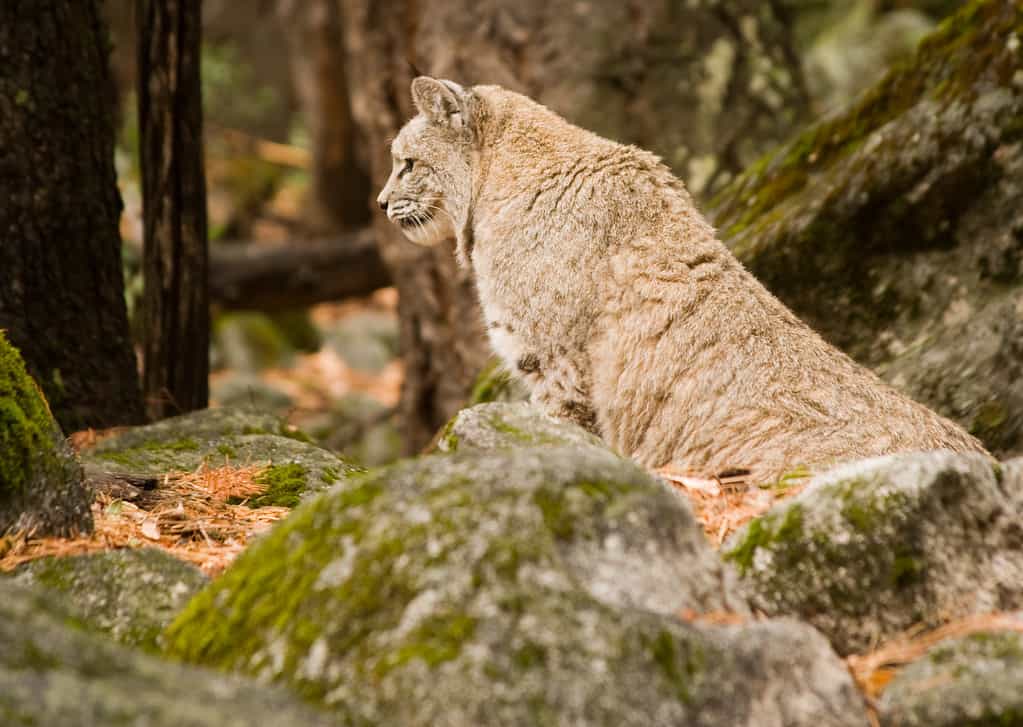
Where to Spot this Animal in Yosemite: In open meadows hunting rodents.
The bobcat is a small but agile cat living in Yosemite. Though they aren’t commonly spotted, they are seen far more often than their much larger counterpart, the mountain lion. I once saw one crossing a meadow near the Ahwahnee hotel.
Bobcats are typically two to three feet in length, tannish in color, and known for their distinctively short bobbed tails. I would compare a bobcat in size that of a large housecat like a Main Coon.
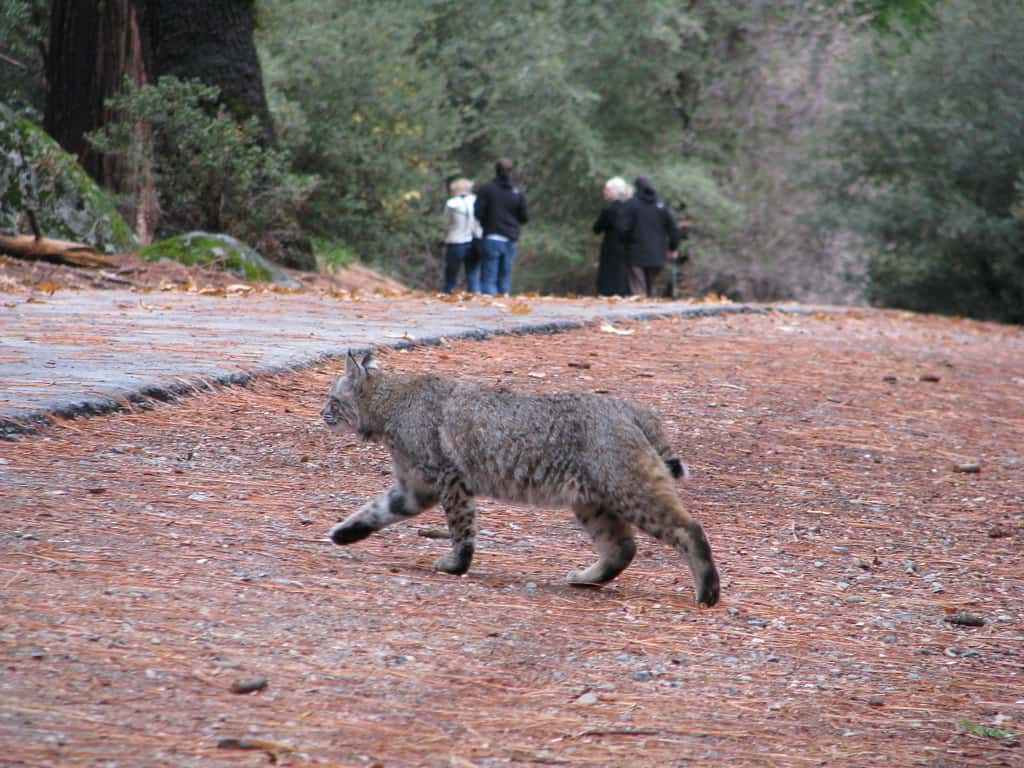
Bobcats can easily climb trees and will hunt in the daytime as well as at night. Like the coyote, them have been seen jumping and diving into the snow to catch rodents. They also like to eat birds and have even been known to occassionally attack deer in deep snow.
Want a guaranteed animal sighting? These are the best zoos in California.
Bats
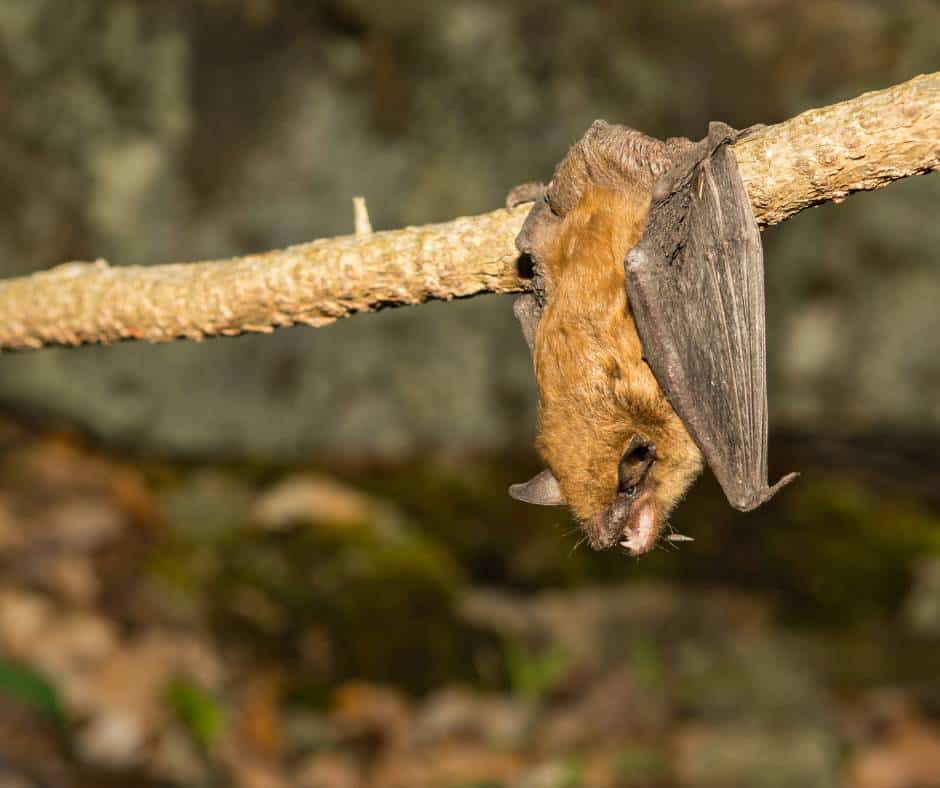
Where to Spot this Animal in Yosemite: In the night’s sky. If you see a “bird” flying in the evening sky, it is likely a bat, the only flying mammals.
Most Common Bat in Yosemite: Big brown bat
Yosemite National Park is home to 17 of the 25 species that exist in California. They are found all over the park, from the lowest elevations to summits above 10,000 feet.
Bats use echo location to find their prey, mainly insects, as they fly across the night sky. They can fly over 15 miles during their 6-7 hour evening hunt.
The largest bat species in North America, the Western mastif, calls Yosemite National Park home. It has a wingspan of 22 inches but is still incredibly light, weighing just over two ounces.
Mountain Lion
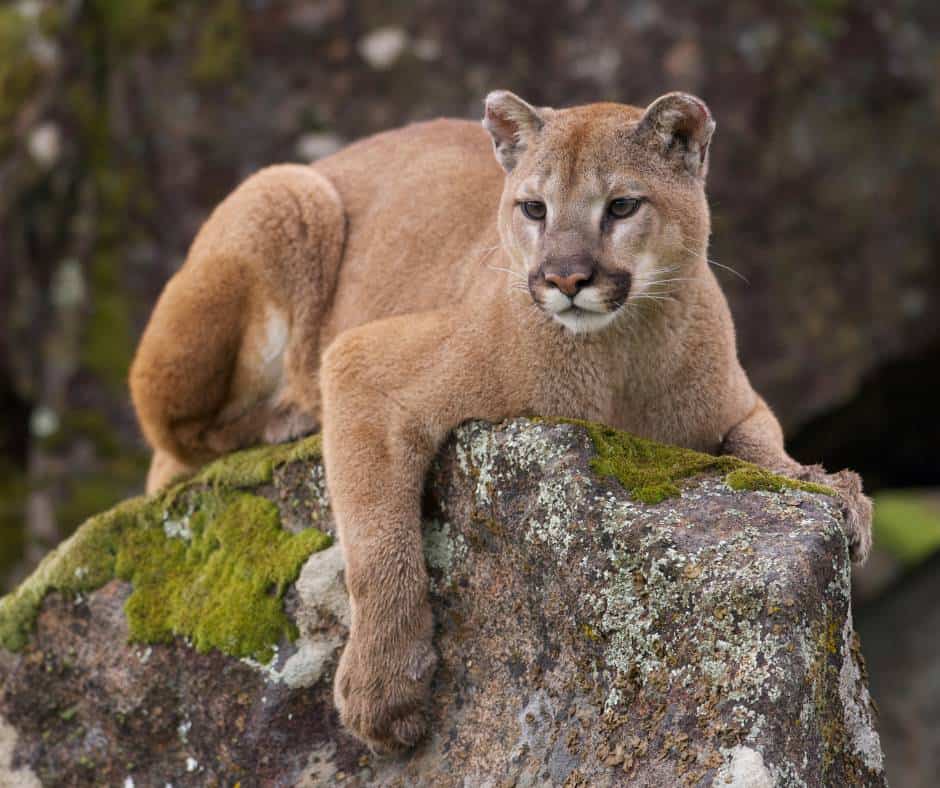
Where to Spot this Animal in Yosemite: Spottings are very rare, but these cats have been seen in the Yosemite Valley as well as the high country.
The mountain lion goes by several names- cougar, puma, panther- but no matter what you call it, this feline is most definitely the largest cat to call Yosemite and the rest of California home. Males are about 130-150lbs and females are much smaller at around 65-90lbs. Mountain lions eat small mammals and tend to hunt at night.
California mountain lions have not had an easy time over the past couple hundred years. Their population has been reduced by hunting and territory loss, but things do seem to be rebounding a bit in the park.
For several years, it was thought that maybe only a dozen cougars lived inside the park, but after an extensive study in 2019, the current number has been estimated to be around 35. Since Yosemite covers 1,169 square miles, that means there is only one mountain lion per 25 miles.
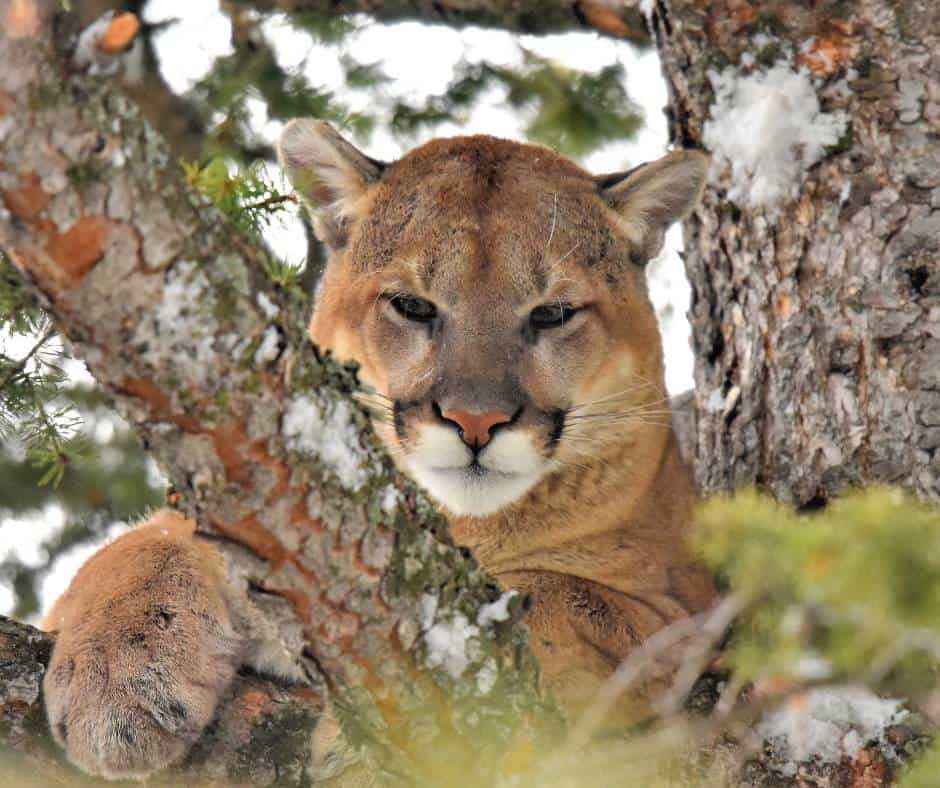
Your chances of ever encountering a mountain lion are quite slim. Still, the cats have been spotted all over the park, from the Yosemite Valley to the Grand Canyon of the Tuolumne River, a wildlife corridor where large mammals have been spotted regularly searching for food, shelter, and mates.
I live in mountain lion country and they have been spotted on the trails that run behind my neighborhood. Dozens of people walk these trails daily without incident. The reality is, a mountain lion is much more likely to see you than you are to see it, and it almost never wants anything to do with a human.
Regardless, if you ever do see a mountain lion DON’T RUN. This will just activate their prey drive. If one starts to approach you act big. Shout in a deep voice. Throw rocks and sticks and maintain eye contact. And remember than whenever you hike with small children you want to keep them close so they don’t get mistaken for prey.
Check out this amazing standoff between a pair of coyotes and a mountain lion near the Ahwahnee Hotel.
Sierra Nevada Bighorn Sheep
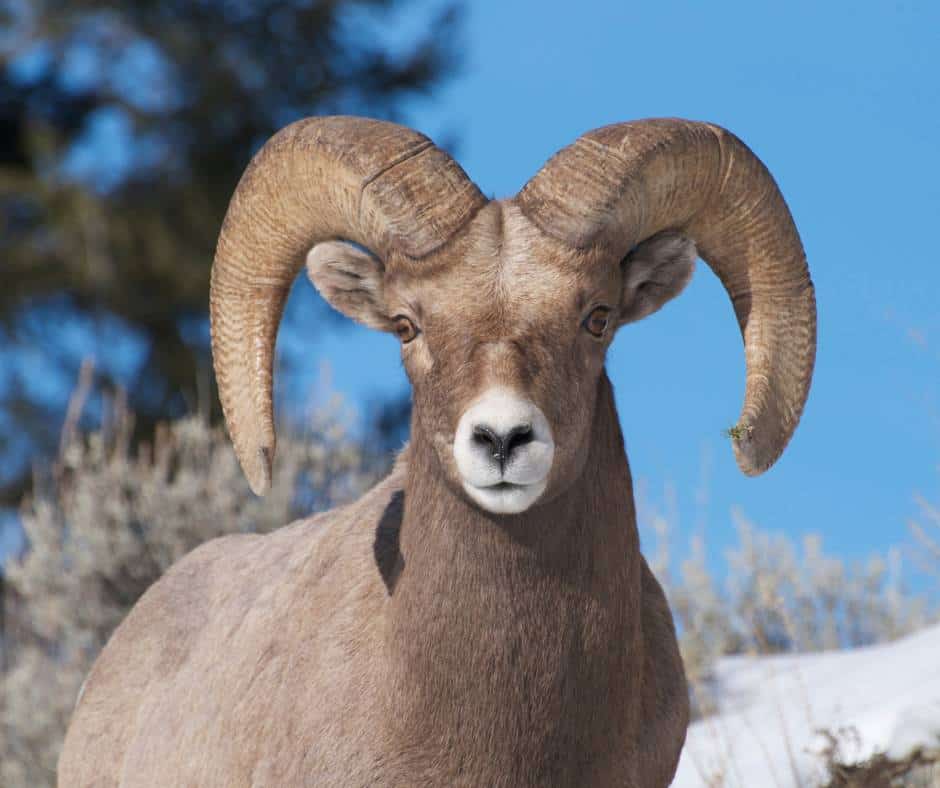
Where to Spot this Animal in Yosemite: Above the 10,000-foot level, mainly in the northeastern corner of the park.
The Sierra Nevada bighorn sheep are an example of a relocation success story. These agile animals went extinct within the park after the first two decades of its formal existence due to over hunting and diseases from domestic sheep brought in by Gold Rush settlers.
In 1986, a small population of just 27 animals were relocated inside the park after a 100 year absence. At first, it didn’t look like the sheep were thriving. But thanks to the Sierra Nevada Bighorn Sheep Recovery Program which was funded by the California legislature, there are now 600 sheep living in Yosemite’s Cathedral Range. They are aso often seen at Summit lake just outside of the park near Mono Pass.
Sierra Nevada Red Fox
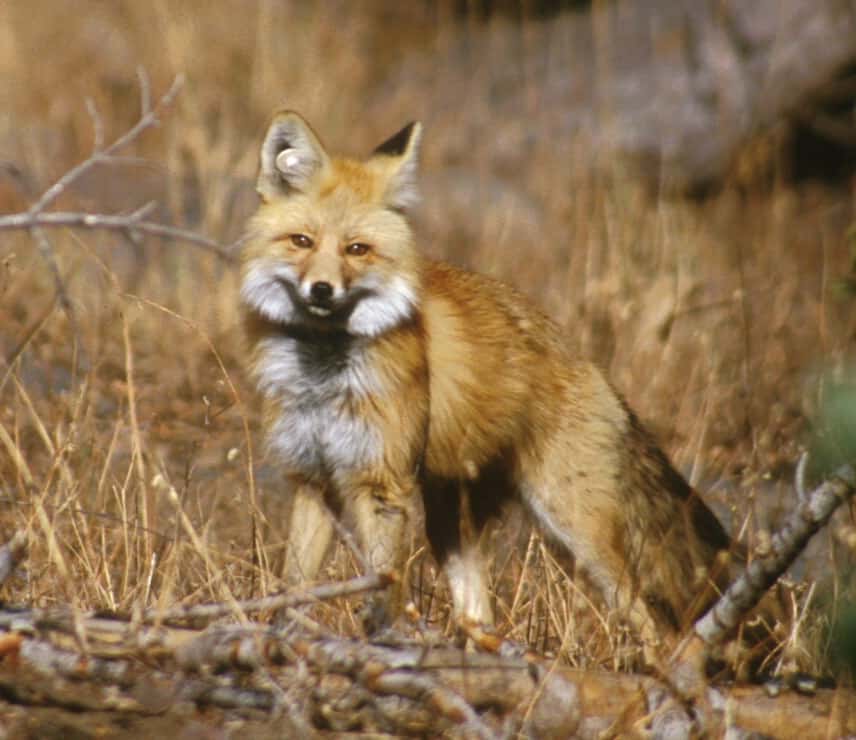
Where to Spot this Animal in Yosemite: You are very unlikely to see this animal, but they do prefer to live at about 6,000 feet in elevation.
After not being seen inside the park since 1916, a motion sensor camera detected the Sierra Nevada red fox inside the park in December 2014. There were thought to be only about 20 of these foxes in their historic range at that point.
This fox is the size of a small house cat, weighing only about eight pounds. It is an effective hunter of rodents, and the fox’s exceptional hearing allows it to hear rodents under the snow to hunt.
The Sierra Nevada red fox is another animal that was the victim of human intervention- as their soft, dense fur was coveted by fur trappers at the turn of the 20th century. Fur trapping has been illegal in California since the mid seventies and the species is endangered.
There have been at least 20 confirmed sightings within the park in the past several years, an encouraging development. If you are lucky enough to spot one, report your sighting online with photo documentation to the state’s wildlife officials.
Fisher
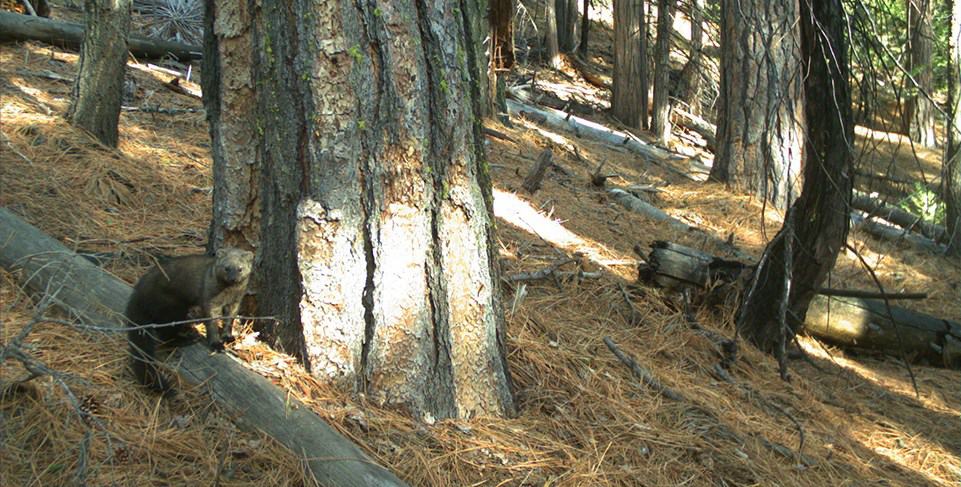
Where to Spot this Animal in Yosemite: Along the Merced River, closer to the southern reaches of the park.
The population of fishers that live in Yosemite National Park and the neighboring Sequoia National Forest is both small and isolated. There are about 200 of these cute critters in what is known as the “southern Sierra Nevada population”.
Just like the Sierra Nevada fox, fishers were victims of fur trappers, but they have also been victimized by habitat loss and logging. Unfortunately, the fishers do not currently have any federal protection, though they are considered a sensitive species by the U.S. Forest Service and the Bureau of Land Management.
Fishers are a member of the weasel family and despite their name, they don’t actually fish. They mainly eat rodents and birds, and are excellent climbers. They are technically omnivores and will eat nuts and berries as well. An adult fisher weighs 8-12 pounds and is three feet long.
Weasel

Where to Spot this Animal in Yosemite: It is possible to see them in the Yosemite Valley, as well as . The range is from the red fir forest up to the timberline.
Weasels are seen more often than one would think, in part because they are known from being fearless. There are both long-tailed and short-tailed weasels inside the park.
Long-tailed weasels are small in size, about the size of a squirrel, with a long tail that makes up half their body length. In the winter, they are primarily white except for the tip of its tail which is white. In the summer, they are mostly brown with lighter creamy yellow underparts.
The short-tailed weasel (also known as a stoat or ermine) is small as well. Only about nine inches in length with, you guessed it, a short tail. Their coloring is similar to the other species of weasel- white in the winter and brown atop and cream underneath in the winter.
Weasels hunt rodents and can do down into their burrows to snag them. They will also eat grasshoppers and frogs.
If you are looking for either of these creatures in the Yosemite Valley they have been known to be spotted near the Yosemite Museum, and the meadows near Swinging Bridge and Sentinel Bridge. The have also been spotted up high near Tioga pass.
Pine Marten
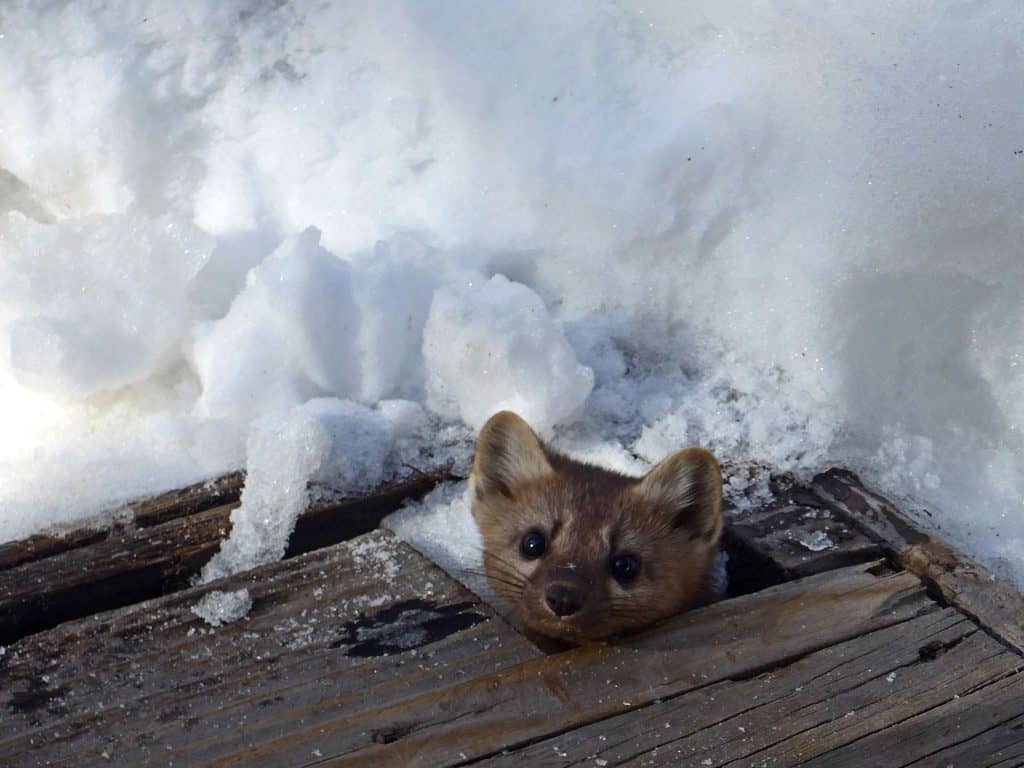
Where to Spot this Animal in Yosemite: Chances of spotting are rare, but they have been seen in Tuolumne Meadows.
Pine martens are another member of the weasel family that lives in Yosemite. It can live anywhere in the red fir belt up to the tree line, but is rarely spotted due to declining populations.
Pine martens are larger than the other weasels, but are still quite small. They weigh 2-3 pounds and are typically 1.5 – 2 feet long. They have a more fox-like face than the other weasels within Yosemite.
Pine martens love to eat voles, but they will eat variety of small rodents including tree squirrels thanks to their strong tree climbing skills. They will also birds when they can catch them.
Martens are active day or night, summer and winter. Though forest animals, they are found in Yosemite around high country rockslides and rocky meadows in summer. They eat small rodents and such birds as they can catch.
Unfortunately, pine martens are not protected by the Endangered Species Act but they are considered a is considered a “species of special concern” by the state of California.
California Badger
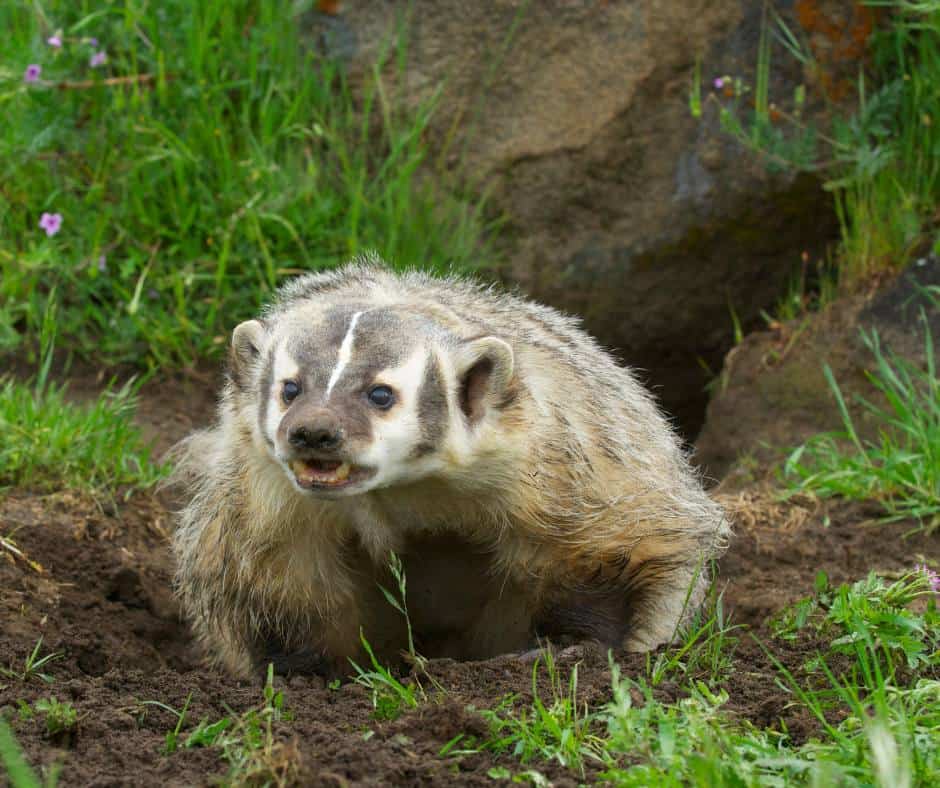
Where to Spot this Animal in Yosemite: Badgers are extremely rare to spot but are most likely found in the open areas of higher elevations. If you do see a badger, be sure to report it.
They look cute as they waddle along the ground but trust that badgers are ferocious predators, with strong claws and powerful jaws. Definitely steer clear if you happen to spot one.
Adult badgers are 2.5 feet loong and weigh about 20 pounds. They are primarily tan with a strong white streak along the center of their head and neck. They use their impressive claws to dig up ground squirrel nests and other rodent tunnels to catch their prey.
Fun Fact: Badger Pass Ski Resort, named for the California badger, is one of only three ski areas inside of a national park.
River Otter
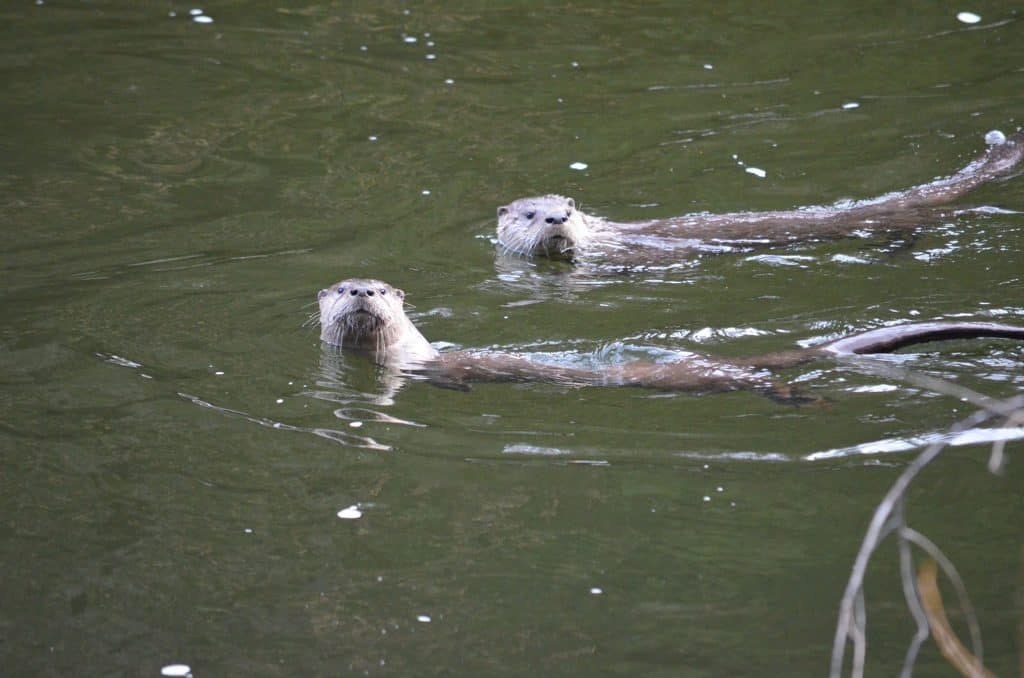
Where to Spot this Animal in Yosemite: In the Merced River both in the Yosemite Valley as well the more western portions of the park.
River otters are relatively recent residents of the Yosemite Valley. They were first seen in the Valley in the Merced River in 2014. There are some theories that they have moved up to these higher elevations because of the drought.
There are currently two known groups (a group of otters on land is a “romp”) known to move in and out of the Yosemite Valley along the river.
The California river otters are dark brown, 11 – 30 pounds, and about four feet in length. They primarily eat fish crayfish, and frogs. If you do see an otter, it will likely be in the water or along the shore.
Love otters? Here are the best places to see sea otters in California.
Beaver

Where to Spot this Animal in Yosemite: In the Merced River at Yosemite Valley, at Mirror Lake, and near Wawona.
There are not many beavers in the Yosemite, but there are a few. They tend to stick to the lower elevations of the park, as well as the Yosemite Valley. Beavers eat the bark of small trees like the cottonwood, and build dams and dens in the waterways.
There is a theory that the river otters have moved into the Yosemite Valley in part because of the beavers. Otters like to take over abandoned beaver lodges.

